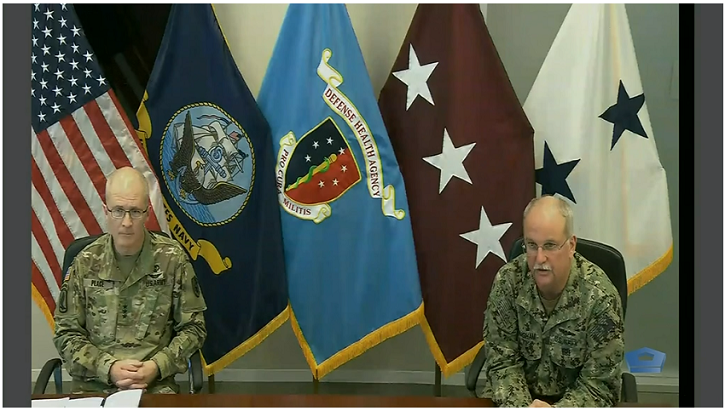
Place addresses DHA COVID-19 response

Lt. Gen. Ronald Place, director of the Defense Health Agency, and Rear Adm. Bruce Gillingham, surgeon general of the Navy, discuss plans for additional COVID-19 response efforts with the Pentagon Press Corps
Army Lt. Gen. Ronald Place, director of the Defense Health Agency, today spoke of agency efforts to address the COVID-19 pandemic within the United States in a telephonic press conference.
Appearing with Rear Adm. Bruce Gillingham, the U.S. Navy surgeon general, Place emphasized DHA’s role in supporting broader Department of Defense efforts to address the crisis, including the creation of a Crisis Action Team that works to address patient concerns, patient care, equipment availability, blood supply monitoring, and sharing DHA capabilities with those who may need them to ensure military forces maintain a high level of operational readiness.
He also stressed DHA’s work to address pressing issues, such as availability of bed spaces; military health capabilities and capacity; the trade-offs of shifting resources from one need to another; assisting people with self-screening; and triage and testing of patients.
Place said within the Military Health System, experts are evaluating reducing elective procedures in the interest of safety and capacity, and has directed doctors and nurses in staff positions to shift responsibilities to clinical patient care as much as possible. DHA is also investigating how clinics and hospitals might be able to surge bed spaces that aren’t currently being used for patient care.
“I want to note how much we appreciate the military community’s positive attitude and particular resilience even as they shoulder their burden of stress, inconvenience, and disruption to their health care during this crisis,” Place said in his opening statement.
Following is the complete opening statement and transcript of the press conference:
Today I want to give you an update on the Defense Health Agency’s and the Military Health System’s support to the national COVID-19 response. Thanks to Mr Hoffman for hosting us virtually and for the teams of folks who make this possible. And thank you to RADM Gillingham, here with me, for making himself available to talk specific to Navy issues, especially about the USNS COMFORT and MERCY.
Mostly, thanks to the reporters here and on the phone, for your attendance and attention to the very important work of the Defense Health Agency. Whatever questions we can’t answer in the time we have scheduled, we’ll be sure to take for action to get back to you as soon as we can.
First, a little context. The Defense Health Agency serves daily 9.5M beneficiaries of the military’s TRICARE health care system—that includes about 1.5M active-duty military personnel. It also includes their family members, Reservists and the military retiree population. DHA is responsible for the providing care through 51 hospitals, and 424 military treatment clinics – and, of course, the USNS COMFORT and USNS MERCY.
I don’t want to go further without noting that care in these facilities for our beneficiaries is being significantly affected by the nationwide response. And I want to note how much we appreciate the military community’s positive attitude and particular resilience even as they shoulder their burden of stress, inconvenience, and disruption to their healthcare during this crisis.
Briefly, what we’re talking about here is how DHA is providing support through the Department of Defense to the whole of government response. We’ve put in place a Crisis Action Team that is working nights and weekends here at our headquarters--on patient concerns, patient care, equipment, monitoring blood supply and sharing our capabilities for the greater cause—all while ensuring we maintain the readiness of our military forces.
And we’re looking at issues that have become familiar to you by now: bed space; military health capabilities and capacity; the trade-offs of shifting resources from one need to another; assisting people with self-screening; and triage and testing of patients.
One statistic that helps tell the story relates to calls we are receiving to our Nurse Advice line – which has jumped to about 500 percent in just a few days, to where we are now fielding about 8,000 calls a day.
Within our system, we are evaluating reducing elective procedures, to increase capacity, and I’ve directed doctors and nurses in staff positions to shift responsibilities to clinical patient care, as much as possible. We’re looking at how our clinics and hospitals might be able surge bed space that isn’t currently being used for patient care. And the list goes on.
I think RADM Gillingham’s description of the issues that arise in mobilizing the COMFORT and MERCY will really be the most tangible way for you to get a sense of how we are approaching these complex issues in real time, so that we’re not just tossing out numbers and jargon at you.
And with that, we’ll take your questions.





















.png)









No hay comentarios:
Publicar un comentario